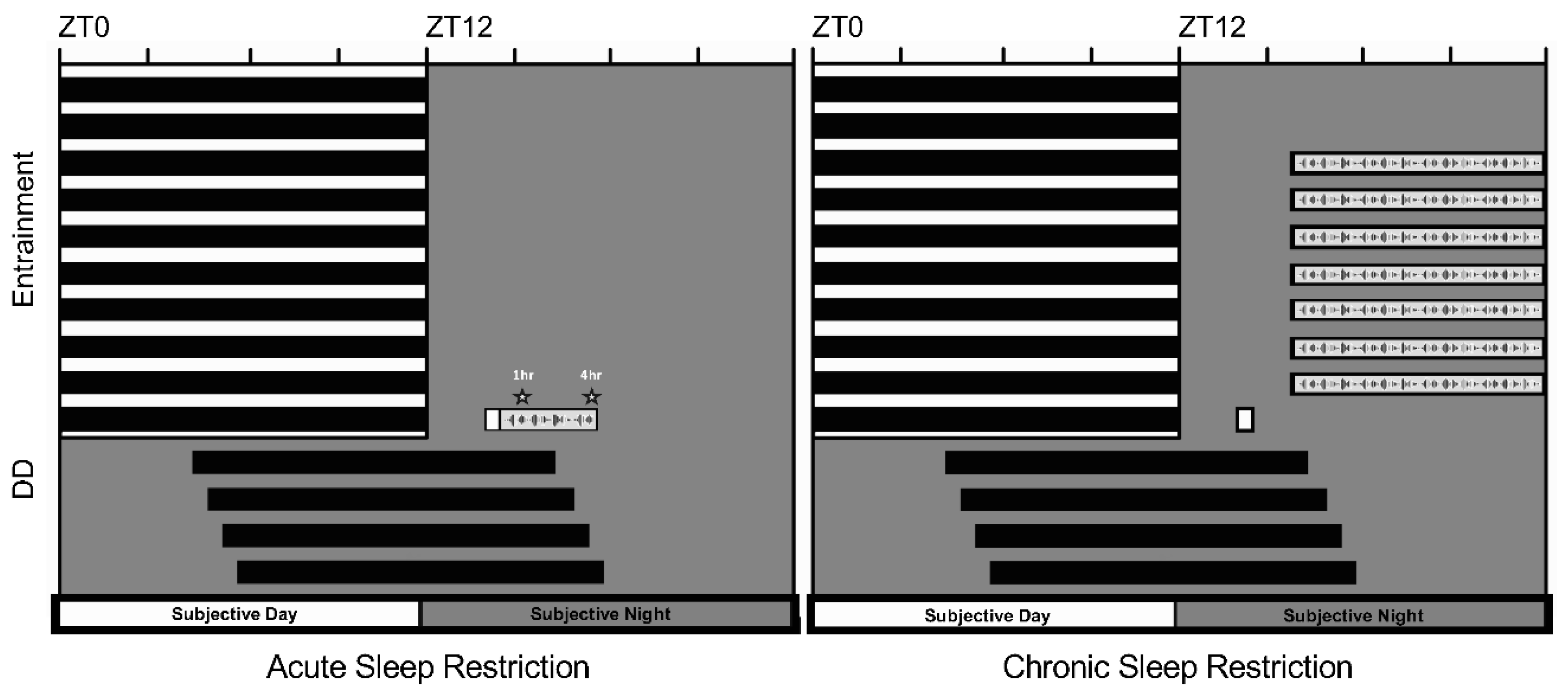Sleep Deprivation Does Not Influence Photic Resetting of Circadian Activity Rhythms in Drosophila
Abstract
:1. Introduction
2. Results
3. Discussion
4. Materials and Methods
Author Contributions
Funding
Institutional Review Board Statement
Informed Consent Statement
Data Availability Statement
Conflicts of Interest
References
- Borbély, A.A. A two process model of sleep regulation. Hum. Neurobiol. 1982, 1, 195–204. [Google Scholar] [PubMed]
- Deboer, T. Sleep homeostasis and the circadian clock: Do the circadian pacemaker and the sleep homeostat influence each other’s functioning? Neurobiol. Sleep Circadian Rhythm. 2018, 5, 68–77. [Google Scholar] [CrossRef] [PubMed]
- Challet, E.; Turek, F.W.; Laute, M.-A.; Van Reeth, O. Sleep deprivation decreases phase-shift responses of circadian rhythms to light in the mouse: Role of serotonergic and metabolic signals. Brain Res. 2001, 909, 81–91. [Google Scholar] [CrossRef]
- Mistlberger, R.E.; Landry, G.J.; Marchant, E.G. Sleep deprivation can attenuate light-induced phase shifts of circadian rhythms in hamsters. Neurosci. Lett. 1997, 238, 5–8. [Google Scholar] [CrossRef]
- van Diepen, H.C.; Lucassen, E.A.; Yasenkov, R.; Groenen, I.; Ijzerman, A.P.; Meijer, J.H.; Deboer, T. Caffeine increases light responsiveness of the mouse circadian pacemaker. Eur. J. Neurosci. 2014, 40, 3504–3511. [Google Scholar] [CrossRef] [PubMed]
- Jha, P.K.; Bouâouda, H.; Gourmelen, S.; Dumont, S.; Fuchs, F.; Goumon, Y.; Bourgin, P.; Kalsbeek, A.; Challet, E. Sleep deprivation and caffeine treatment potentiate photic resetting of the master circadian clock in a diurnal rodent. J. Neurosci. 2017, 37, 4343–4358. [Google Scholar] [CrossRef]
- Burgess, H.J.; Eastman, C.I. Short nights attenuate light-induced circadian phase advances in humans. J. Clin. Endocrinol. Metab. 2005, 90, 4437–4440. [Google Scholar] [CrossRef] [Green Version]
- Burgess, H.J. Partial sleep deprivation reduces phase advances to light in humans. J. Biol. Rhythm. 2010, 25, 460–468. [Google Scholar] [CrossRef]
- Burke, T.M.; Markwald, R.R.; McHill, A.W.; Chinoy, E.D.; Snider, J.A.; Bessman, S.C.; Jung, C.M.; O’Neill, J.S.; Wright, K.P. Effects of caffeine on the human circadian clock in vivo and in vitro. Sci. Trans. Med. 2015, 7, 305ra146. [Google Scholar] [CrossRef] [Green Version]
- Foster, R.G.; Helfrich-Forster, C. The regulation of circadian clocks by light in fruitflies and mice. Philos. Trans. R. Soc. Lond. B Biol. Sci. 2001, 356, 1779–1789. [Google Scholar] [CrossRef] [Green Version]
- Shaw, P.J.; Cirelli, C.; Greenspan, R.J.; Tononi, G. Correlates of sleep and waking in Drosophila melanogaster. Science 2000, 287, 1834–1837. [Google Scholar] [CrossRef] [PubMed] [Green Version]
- Larkin, J.E.; Yokogawa, T.; Heller, H.C.; Franken, P.; Ruby, N.F. Homeostatic regulation of sleep in arrhythmic Siberian hamsters. Am. J. Physiol. Regul. Integr. Comp. Physiol. 2004, 287, R104–R111. [Google Scholar] [CrossRef] [PubMed] [Green Version]
- Edgar, D.M.; Dement, W.C.; Fuller, C.A. Effect of SCN lesions on sleep in squirrel monkeys: Evidence for opponent processes in sleep-wake regulation. J. Neurosci. 1993, 13, 1065–1079. [Google Scholar] [CrossRef] [PubMed] [Green Version]
- Wisor, J.P.; O’Hara, B.F.; Terao, A.; Selby, C.P.; Kilduff, T.S.; Sancar, A.; Edgar, D.M.; Franken, P. A role for cryptochromes in sleep regulation. BMC Neurosci. 2002, 3, 20. [Google Scholar] [CrossRef] [PubMed] [Green Version]
- Dijk, D.-J.; Visscher, C.; Bloem, G.; Beersma, D.; Daan, S. Reduction of human sleep duration after bright light exposure in the morning. Neurosci. Lett. 1987, 73, 181–186. [Google Scholar] [CrossRef] [Green Version]
- Krauchi, K.; Knoblauch, V.; Wirz-Justice, A.; Cajochen, C. Challenging the sleep homeostat does not influence the thermoregulatory system in men: Evidence from a nap vs. sleep-deprivation study. Am. J. Physiol.-Regul. Integr. Comp. Physiol. 2006, 290, R1052–R1061. [Google Scholar] [CrossRef] [Green Version]
- Birchler-Pedross, A.; Schröder, C.M.; Münch, M.; Knoblauch, V.; Blatter, K.; Schnitzler-Sack, C.; Wirz-Justice, A.; Cajochen, C. Subjective well-being is modulated by circadian phase, sleep pressure, age, and gender. J. Biol. Rhythm. 2009, 24, 232–242. [Google Scholar] [CrossRef]
- Kaladchibachi, S.; Fernandez, F. Precision light for the treatment of psychiatric disorders. Neural Plast. 2018, 2018, 5868570. [Google Scholar] [CrossRef] [Green Version]
- Zeitzer, J.M.; Fisicaro, R.A.; Ruby, N.F.; Heller, H.C. Millisecond flashes of light phase delay the human circadian clock during sleep. J. Biol. Rhythm. 2014, 29, 370–376. [Google Scholar] [CrossRef]
- Kaladchibachi, S.; Secor, M.A.; Negelspach, D.C.; Fernandez, F. Longitudinal study of sleep and diurnal rhythms in Drosophila ananassae. Exp. Gerontol. 2019, 116, 74–79. [Google Scholar] [CrossRef]
- Aschoff, J. Response curves in circadian periodicity. In Circadian Clocks; North-Holland Publishing Co.: Amsterdam, The Netherlands, 1965; pp. 95–111. [Google Scholar]
- Kayser, M.S.; Mainwaring, B.; Yue, Z.; Sehgal, A. Sleep deprivation suppresses aggression in Drosophila. Elife 2015, 4, e07643. [Google Scholar] [CrossRef] [PubMed]
- Vienne, J.; Spann, R.; Guo, F.; Rosbash, M. Age-related reduction of recovery sleep and arousal threshold in Drosophila. Sleep 2016, 39, 1613–1624. [Google Scholar] [CrossRef] [Green Version]
- Kaladchibachi, S.; Negelspach, D.C.; Fernandez, F. Circadian phase-shifting by light: Beyond photons. Neurobiol. Sleep Circadian Rhythm. 2018, 5, 8–14. [Google Scholar] [CrossRef] [PubMed]
- Negelspach, D.C.; Kaladchibachi, S.; Fernandez, F. The circadian activity rhythm is reset by nanowatt pulses of ultraviolet light. Proc. Biol. Sci. 2018, 285, 20181288. [Google Scholar] [CrossRef] [PubMed]


Publisher’s Note: MDPI stays neutral with regard to jurisdictional claims in published maps and institutional affiliations. |
© 2022 by the authors. Licensee MDPI, Basel, Switzerland. This article is an open access article distributed under the terms and conditions of the Creative Commons Attribution (CC BY) license (https://creativecommons.org/licenses/by/4.0/).
Share and Cite
Negelspach, D.C.; Kaladchibachi, S.; Dollish, H.K.; Fernandez, F.-X. Sleep Deprivation Does Not Influence Photic Resetting of Circadian Activity Rhythms in Drosophila. Clocks & Sleep 2022, 4, 202-207. https://doi.org/10.3390/clockssleep4010018
Negelspach DC, Kaladchibachi S, Dollish HK, Fernandez F-X. Sleep Deprivation Does Not Influence Photic Resetting of Circadian Activity Rhythms in Drosophila. Clocks & Sleep. 2022; 4(1):202-207. https://doi.org/10.3390/clockssleep4010018
Chicago/Turabian StyleNegelspach, David C., Sevag Kaladchibachi, Hannah K. Dollish, and Fabian-Xosé Fernandez. 2022. "Sleep Deprivation Does Not Influence Photic Resetting of Circadian Activity Rhythms in Drosophila" Clocks & Sleep 4, no. 1: 202-207. https://doi.org/10.3390/clockssleep4010018
APA StyleNegelspach, D. C., Kaladchibachi, S., Dollish, H. K., & Fernandez, F. -X. (2022). Sleep Deprivation Does Not Influence Photic Resetting of Circadian Activity Rhythms in Drosophila. Clocks & Sleep, 4(1), 202-207. https://doi.org/10.3390/clockssleep4010018




